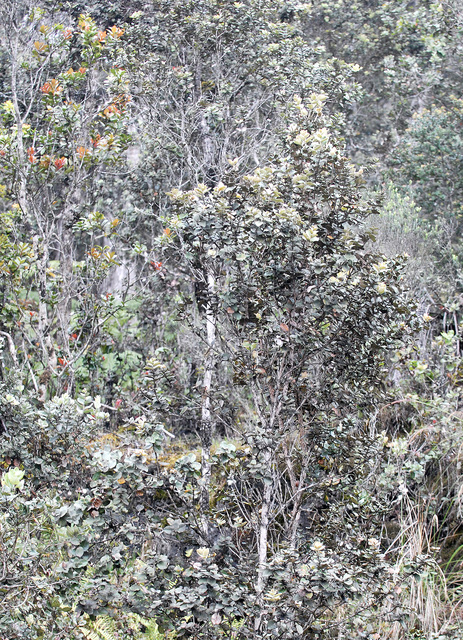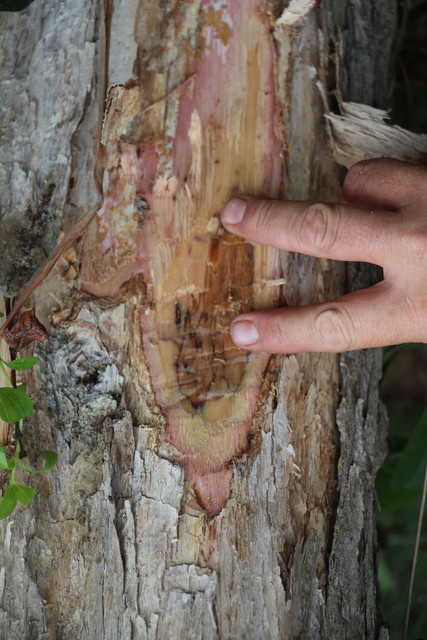KAILUA-KONA — They say bad news never travels alone.
As West Hawaii contends with dengue fever and the possibility that the disease could become endemic, a researcher has revealed that the another scourge is spreading on leeward slopes — rapid ohia death.
The fungus, which spread swiftly over more than 16,000 acres in East Hawaii, has been discovered in trees in Holualoa and Kealakekua, said James Friday, an extension forester with the College of Tropical Agriculture and Human Resources in Hilo.
The finding was confirmed a couple of weeks ago following tests of samples from the west side, Friday told West Hawaii Today in an email.
The news helped set the table for an invasive species forum held Tuesday night in Kailua-Kona, where updates were given on the battle against numerous pests that have besieged the island — including fire ants, coqui frogs and the new bagrada bug.
Ohia wilt kills 50 percent of the trees it infects, and the affected area in Puna and mauka slopes above Hilo ballooned to 16,000 acres in 2014, from less than 3,000 acres in 2012. The fungus rapidly kills by taking over the tree’s water transport system. Scientists believe that humans can spread the spores on their clothing, vehicles and equipment. They can also be transported through mud on wheels and vehicles.
Friday urged washing vehicles and disinfecting tools.
“Don’t move wood around, don’t move plants around,” Friday told a packed Council Chambers at the forum sponsored by Rep. Nicole Lowen. “Kaloko mauka is what I’m really worried about. You buy infected wood from Puna, cut it up in your driveway, the sawdust blows around, and you just infected your forest.”
Friday said the fungus can be found on taro and sweet potatoes, but this particular strain is new to science.
“The difficulty is we don’t know where it came from, or what it came in on,” Friday said.
The Hawaii Department of Agriculture launched an effort to contain the disease with an emergency ban on shipments of ohia logs and other products off of the island in August. A ban on soil export will begin in January.
Rapid ohia death is just the latest in a long saga of detrimental organisms taking up residence here. The lack of a coordinated response has made Hawaii one of the worst states for invasive species, said Christy Martin, public information officer for the Coordinating Group on Alien Pest Species.
“Hawaii has no comprehensive biosecurity plan,” Martin said. “We need a 10-year plan so legislators and everyone can look at it and say, this is our responsibility.”
Little fire ants have been a problem in east Hawaii since 1999, leaving stings and welts and spreading through the transport of cars, plants and household goods. The pest is now at 25 to 30 locations in West Hawaii and at least one in Waimea, said Robert Curtiss, a West Hawaii entomologist for the Hawaii Department of Agriculture.
“They’ll take over an entire property, and you won’t be able to go into your yard without getting stung,” he said.
Because the ants spread across property boundaries, neighbors and communities must collaborate to combat them effectively, Curtiss said. Coffee farmers and others have worried widespread infestations on the west side would severely limit the ability to hand-harvest fields.
Waste mulch at county transfer stations is not properly treated for fire ants and should be avoided, said Springer Kaye, manger of the Big Island Invasive Species Council.
“I wouldn’t take that mulch at any price,” she said.
Bagrada bug is a new pest, believed to have been here about a year, Curtiss said. The invasive stink bug damages vegetable crops and has been found in the Kona districts, Waimea and up to 9,000 feet at the Mauna Kea Visitor Center.
“It’s pretty clear it got up there by people moving plant material,” Curtiss said.











